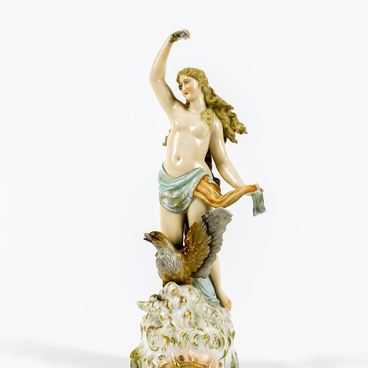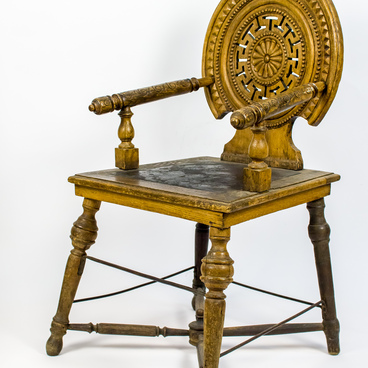The exhibition presents a life-sized female bust on a round stand. A plaque with the inscription “Property of the workshop of Yu. F. Brockman, 10, Neglinnaya st.” has been preserved on the base.
In the Russian Empire at the beginning of the 20th century, paints, brushes, easels, pencils, and everything necessary for painting could be purchased in specialized retail stores of artist’s materials. In addition, art materials could be bought in numerous stationery and bookstores. Their assortment included both European and domestic products.
The highest demand among buyers was for high-quality materials produced abroad. Foreign goods were trusted more, so the names of European cities were often found in the names of stores. One of these stores was the “Berlin Art Store of Yu. F. Brockman”, founded in 1877. Brockman called his store “Berlin” because he sold German products: paints from the Berlin Meves factory, pencils from Faber, artistic watercolors by Gunther Wagner.
The sculpture presented in the exhibition decorated the interior of the house of one of the Tetyush merchants. After the nationalization of the merchant’s property, it entered the museum collection.
The vertical section of the bust shoulders is characteristic of sculptures in the Art Nouveau style, which was popular in the late 19th and early 20th centuries. This was often the shape of shop mannequins displaying women’s jewelry and the models with which beginner artists worked.
Busts and other sculptural images decorated the interiors of not only noble mansions but also merchant houses. The fashion for statues in the antique spirit came to Russia at the beginning of the 19th century from France, when the Empire style became popular, which was characterized by imitation of antiquity. It was manifested not only in architecture but also in the design of interiors, dishes, furniture. These objects were distinguished by strict symmetry, an abundance of gilding, decorative elements. The Russian Empire style is sometimes called Alexander’s classicism since it was popular during the reign of Alexander I.
In the Russian Empire at the beginning of the 20th century, paints, brushes, easels, pencils, and everything necessary for painting could be purchased in specialized retail stores of artist’s materials. In addition, art materials could be bought in numerous stationery and bookstores. Their assortment included both European and domestic products.
The highest demand among buyers was for high-quality materials produced abroad. Foreign goods were trusted more, so the names of European cities were often found in the names of stores. One of these stores was the “Berlin Art Store of Yu. F. Brockman”, founded in 1877. Brockman called his store “Berlin” because he sold German products: paints from the Berlin Meves factory, pencils from Faber, artistic watercolors by Gunther Wagner.
The sculpture presented in the exhibition decorated the interior of the house of one of the Tetyush merchants. After the nationalization of the merchant’s property, it entered the museum collection.
The vertical section of the bust shoulders is characteristic of sculptures in the Art Nouveau style, which was popular in the late 19th and early 20th centuries. This was often the shape of shop mannequins displaying women’s jewelry and the models with which beginner artists worked.
Busts and other sculptural images decorated the interiors of not only noble mansions but also merchant houses. The fashion for statues in the antique spirit came to Russia at the beginning of the 19th century from France, when the Empire style became popular, which was characterized by imitation of antiquity. It was manifested not only in architecture but also in the design of interiors, dishes, furniture. These objects were distinguished by strict symmetry, an abundance of gilding, decorative elements. The Russian Empire style is sometimes called Alexander’s classicism since it was popular during the reign of Alexander I.



